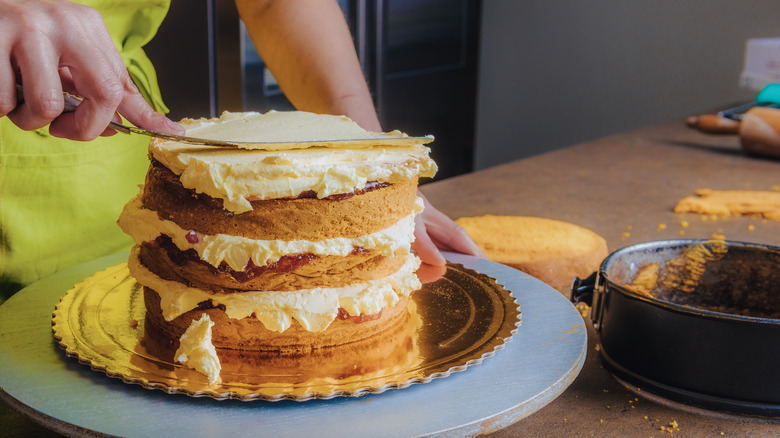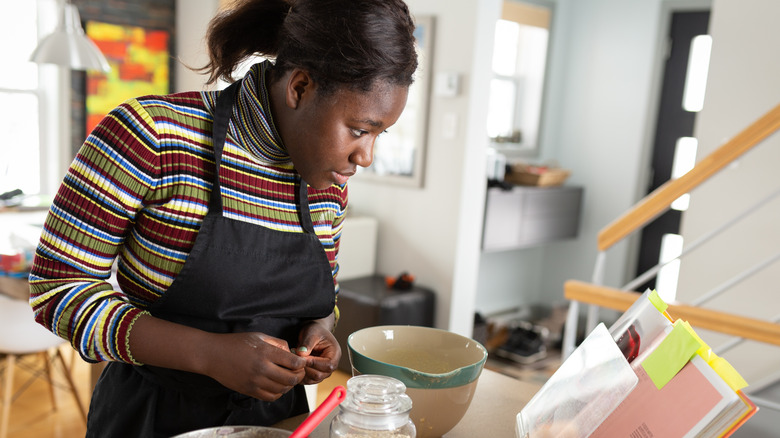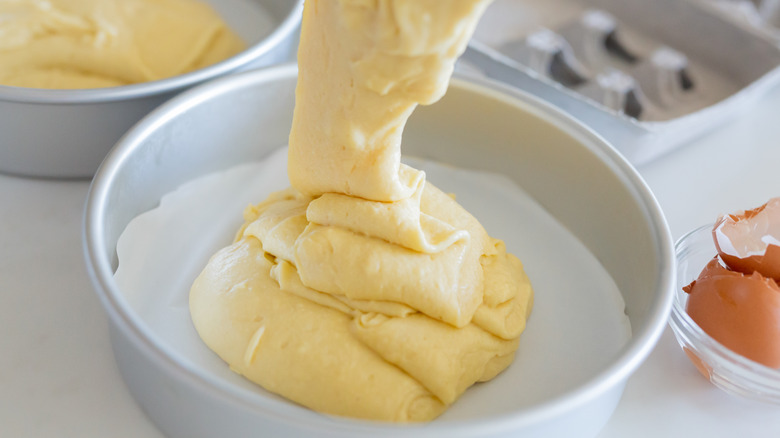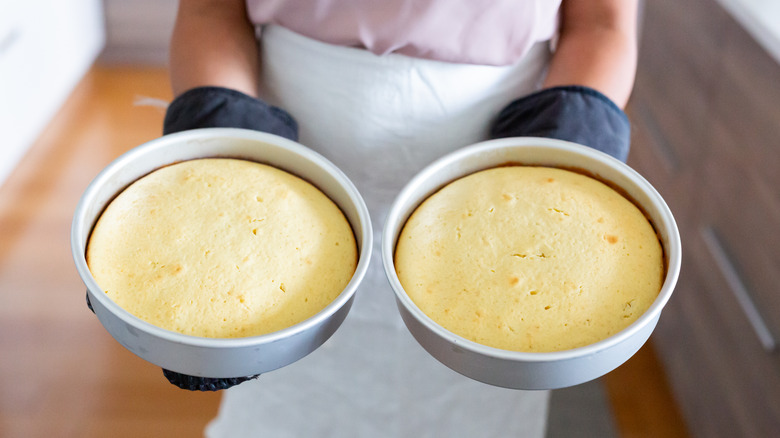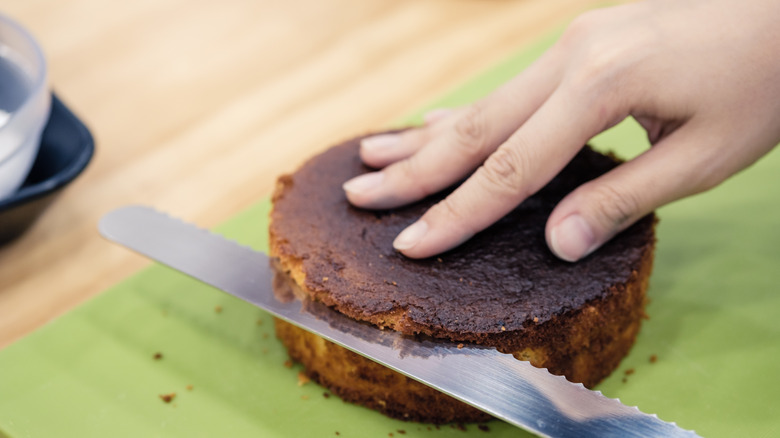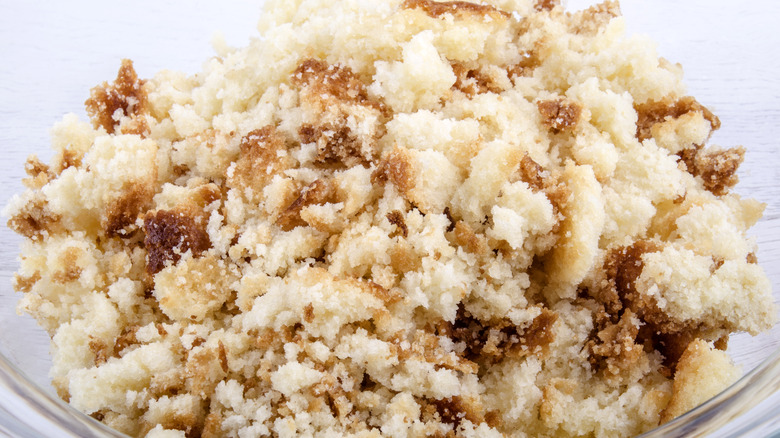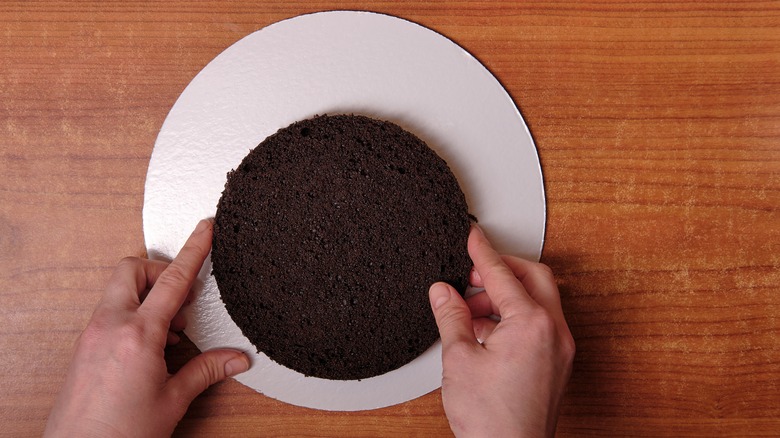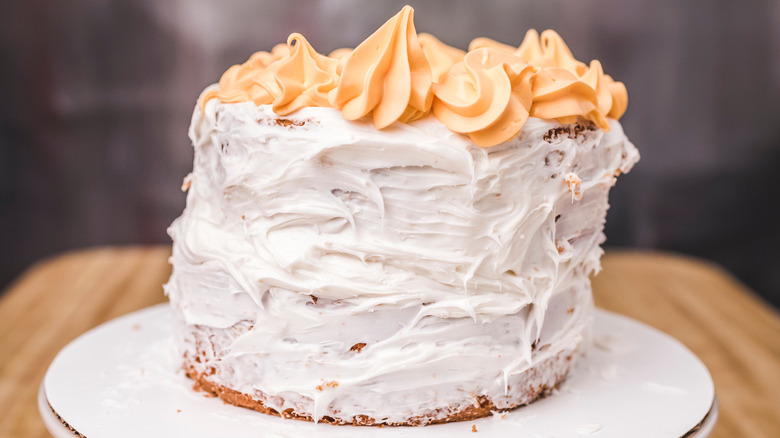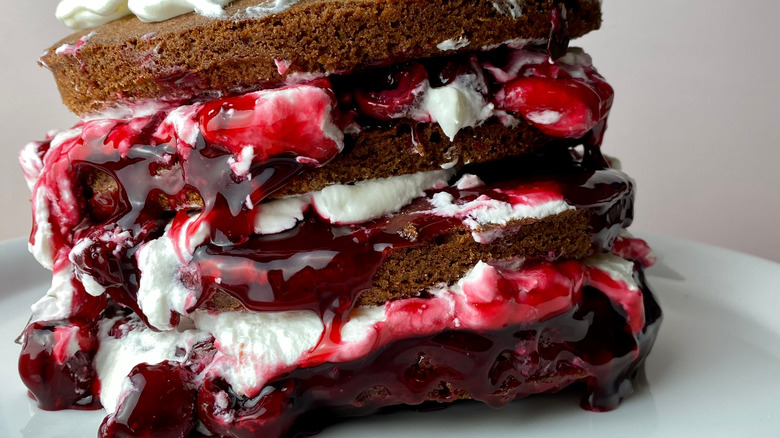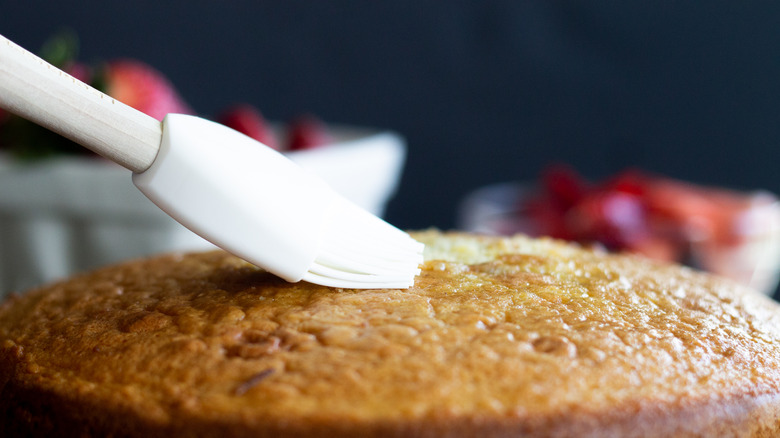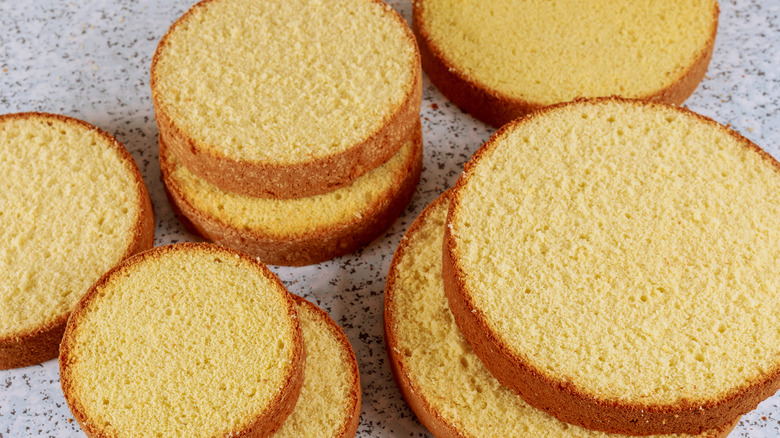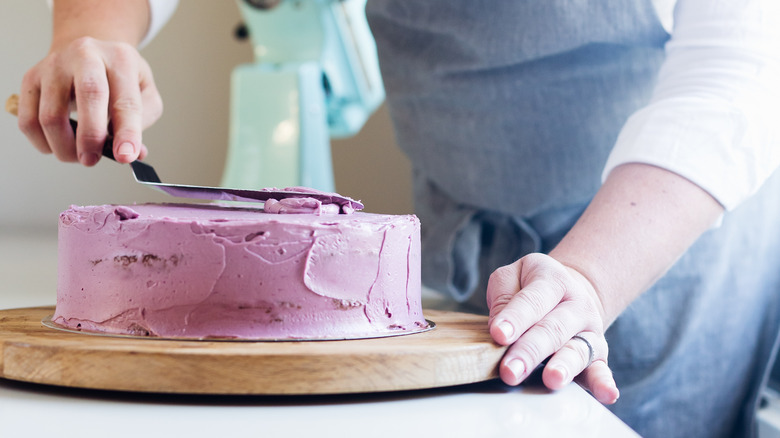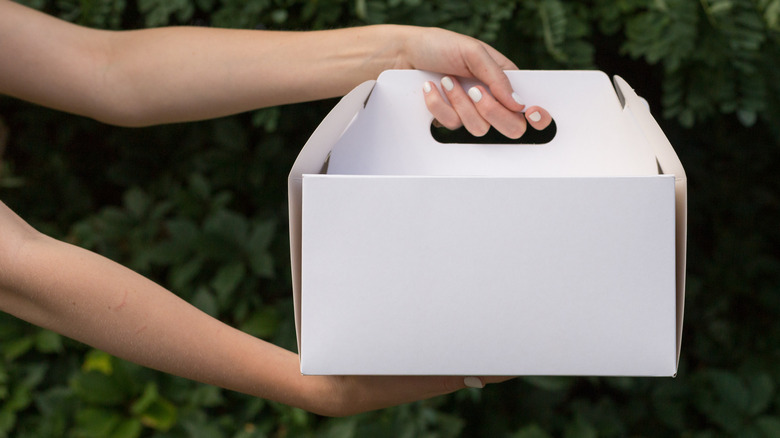14 Layer Cake Mistakes Everyone Makes
From the recipe to how you choose to how you serve it, plenty of factors go into making a show-stopping layer cake. Since these desserts have such a distinguished look, it is quite easy to tell when there are flaws in their presentation and execution. Sometimes, when you slice into one, it's clear as day that the creator oversoaked it, stacked it improperly, or supplied it with more frosting than the actual cake. And, of course, the worst-case scenario is that the dessert resembles the Leaning Tower of Pisa.
It's an understatement to say that there is more than one way to inadvertently mess up your layer cake, despite the fact that it's an achievable process once you get into the groove. However, when you are aware of common mistakes people make with this type of sweet treat, it is helpful in the long run because then you know which mishaps to avoid. So, the next time you set out to construct a high-rise cake, keep these missteps in mind, and the process will be much more pleasant.
Choosing the wrong cake recipe
People who are new to layer cakes make the error of using specific recipes that are incredibly fragile baked goods and can't hold weight. While extra airy cake, like foam cake, is scrumptious, it doesn't have the structure to carry thick buttercream, puddings, fresh fruit, or any other fillings you use. Furthermore, folks might go to the other extreme and use overly dense cakes, which bake best in a loaf or Bundt pan and don't turn out well in round or sheet pans.
If someone tries to bake those kinds of cakes in the wrong pan, the edges burn before it cooks thoroughly in the center. Finally, when home bakers don't do their research and use butter cakes or sponge cakes as their dessert's foundation, it causes them unnecessary trouble. Instead, choose a formula with the perfect moisture and density balance. Otherwise, the cake is too dry to soak with simple syrup or so soft that it caves in when stacked.
Only using round pans
One hindrance that people unknowingly create for themselves is that they only use round cake pans when they can use a much simpler method. Although round pans are extremely common, sometimes, the cakes bake much differently than each other. For example, one cake unmolds easily from the pan while the other doesn't, which leaves the baker with one broken cake. Other times, the person doesn't evenly distribute the batter between the pans, or they bake the pans on separate oven shelves, which causes noticeable dissimilarities in appearance.
In any case, when individuals use various pans, it might leave them with cakes that don't look alike; the different layers turn out darker and thicker, or they have sides that aren't perfectly linear. This is why it's beneficial to bake the batter on large sheet pans instead and then use cake rings to cut out the circles. Cake rings are like an oversized cookie or biscuit cutters; it creates identical shapes with upright sides. The pieces are much more orderly and easier to stack and frost. Plus, you can make unique shapes with them, too, not just circles.
Working with warm cake
Unfortunately, some people don't plan ahead to give ample time for their layers to cool before they assemble the cake. Or they might just be too antsy to wait or assume that using warm cake isn't as crucial as it actually is. Whichever the case, when people assemble a layer cake prematurely, it raises the chance that the cake will not have the strength to hold the filling. Furthermore, the high temperature of the cake melts the frosting, which changes its consistency and makes it difficult to control. The icing becomes soupy and slides down the sides of the cakes in extreme cases.
However, you might not even make it to that stage of the cake-building procedure because the layers might crack and crumble if you level them with a knife when they're not ready. Seemingly, there are multiple reasons why you should allow the cakes to reach room temperature before you touch them. If you are in a time crunch, relocate the warm cakes to the fridge to accelerate the process so that they become less delicate.
Carelessly cutting the layers
Don't get us wrong — it isn't the easiest thing to perfectly cut straight cake layers, especially if you are a beginner baker. However, when people are not cautious about the size and straightness of their layers, it can be a costly mistake for the whole cake and can make the presentation much less impressive.
Moreover, if you create layers that are too thin, the cake easily breaks when you try to move it, and it succumbs to the weight of the frosting after just a few layers. For these reasons, people should have a general idea of how to torte a cake before they take on the challenge, and they shouldn't cut each layer any less than one inch in thickness.
For bakers who like to make the most eye-catching cake possible, they fall short when they use the wrong kind of knife — like a short paring knife — instead of a long-serrated one that's relatively flat. If you're not yet comfortable with your cake leveling skills, there are tools you can purchase, which often have a wire or blade that allows you to saw through the cake in an unwavering motion. Similarly, you can use dental floss to cut your cake to attain an almost identical outcome.
Discarding the scraps
Some people tend to toss the extra cake scraps when they trim their sweet treats. Although it preserves the work area's cleanliness, this action can come back to bite them if any issues arise with the cakes during the assembly process. For instance, if a baker disposes of the cake crumbs or edges right away, and one of their layers breaks into pieces, they won't have the scraps to help patch any holes. Or, if they build the cake only to find it isn't level, they have to use additional frosting to get the cake even instead of using the cake pieces, which are beyond functional.
The leftover pieces might seem useless at first, but there are many ways in which they come in handy. Then, of course, they can operate as cake pop bases or ice cream toppings later if no cake problems occur. So, don't create unnecessary food waste by discarding them — you've got nothing to lose when you keep them around.
Not securing the bottom layer to the cake board
Home bakers often construct their layer cakes without ensuring the bottom piece is appropriately fixed to the cake board first. This practice is dangerous because once they entirely ice and decorate the cake, it can slide off the board and drop to the floor. It's just as high risk if the individual needs to transport the cake to a different location because it might move around in the cake box.
Even those who don't own cardboard rounds and just assemble their cake straight on a platter still shouldn't pass over the step of securing it. All you need to do to prevent the confection from slipping and sliding is spread a bit of buttercream on the base where you plan to assemble it — press the cake down slightly to adhere to it. The frosting acts as an edible glue, and since it is already part of the sweet treat, guests won't even notice a smidge of it on the bottom of their slice.
Failing to align the cake after each layer addition
Some individuals wait until they've entirely stacked their cake before they observe if it is level and has straight sides. Unfortunately, if the cake is lopsided at that point, it might be too late to fix it. If the surface of the cake leans to one side more than the other, fresh fruit and other toppings might fall toward the lower side. Of course, crooked cakes taste just as delicious, but people want the most pristine-looking cake — especially for those extra special occasions.
In addition, if the sides are dramatically uneven, the different components between the layers ooze out, such as mousse or curd. So, next time you're making a cake, examine each new layer's level to avoid these mishaps. When it is still a work in progress, it is much easier to manually adjust a layer to make the sides more linear or lightly press the top to make it flatter.
Applying the filling incorrectly
If you don't have much experience with filling cake layers, you might make the mistake of using too much too soon. Once you place heaps of jam or other components between the fluffy cake pieces, the heavy weight of the filling can make the cake cave in on itself. Plus, it sometimes has nowhere to go once you put the other pieces of cake on top, causing it to leak out of the edges and drip down the sides. Sometimes, this can be a stylistic choice if done right.
Other times, it's evidence of poor planning. This isn't too hideous if the bakers use the same frosting for the filling and the outer coating. However, when people use a different colored icing or pudding, it clashes with the other frosting in the crumb coat and looks messy. If you have a bright red cherry filling for the center of the cake and a classy white buttercream on the outside, you certainly need to lock in the cherry mixture so that it does not gush out.
When people neglect to make a dam for their cake, they give the opportunity for the filling to do just that. To take the proper steps, use the white buttercream and pipe a ring on the outer edge of the layer you are going to fill, then place the fruity mixture inside of that ring, and spread it until it reaches the buttercream. Repeat this for every layer.
Soaking the cake too much
One less obvious yet common mistake that people make when they craft a layer cake is that they oversoak it. It's true that simple syrup prevents the final result from being dry. However, there is a point at which it is too much. When people immerse their soft cake with too much liquid, it loses its much-needed structure and becomes mushy. Especially if they pile the over-moist dessert with layers of frosting, jam, or even fondant, it has no chance of lasting.
Although particular soaked cakes, like tres leches, are undeniably tasty, the surplus of fluid doesn't work with cakes you plan to stack high. Hence, when you moisten a cake, only go over each layer once with a pastry brush or squeeze bottle. If you worry your cake is too dry, flip it over to soak the underside too. Whatever you do, don't drench it so much that it leaks or falls apart.
Not being particular about your top layer
It is common to get carried away during the assembling process and not precisely plan how you might use the different layers. Some bakers might not think it matters which ends up on top and which works best at the bottom. But again — unless you are a cake-making professional, it might be worth considering putting some thought into what layer to use on top.
Some of the layers might end up slightly cracked, thinner than the others, or darker in color. So, if you don't pay attention to these tiny details, flawed pieces might function as the finishing layer, which is the most visible to the eye and needs to be frosted more carefully.
Many people often use the crumbly, trimmed side of the layer as the top surface of the cake that they need to frost. Unfortunately, this makes it a pain to spread the frosting because the crumbs constantly lift since they're exposed. Instead, flip it over before you place that final layer on so that the crusted side acts as the face of the dessert and the frosting glides on effortlessly.
Not using extra support for ultra-tall cakes
Many people think dowels are excessive if they have a one-tier cake. Yet, if the single tier has seven layers or more, it can become unstable if they fail to use them. Primarily if bakers use very loose or heavy fillings, the cake lacks strength without that proper extra support. This remains true if you plan to top the cake with decorations on the heavier side that might sink into the sweet treat. Dowels are great in these cases as they act as a substructure for cake toppers and decorations to sit upon.
It's also not a great idea to neglect that double barrel cakes need more assistance — they have the contents of two full-sized cakes stacked on top of each other. When bakers don't include a cake board halfway through the layering process, the bottom cakes fall from the weight of all the layers on top of them. So, if you plan to make sky-high cakes, take supplementary action with boards or dowels so they can bear all the weight instead of leaving it to chance.
Forgetting to do a crumb coat
Having a crumb coat is not something that home bakers should avoid, especially if you want your layer cake to have a compelling, crumb-free look. For those unfamiliar with what a crumb coat is and why your cake might need one, it's simply when people spread a paper-thin coating of frosting around the cake. Before doing so, bakers make certain the cake is straight and positioned correctly. Then they apply it and let it refrigerate so the crumb coat hardens. Doing this gives the perfect base for the actual layer of frosting to reside on and seals any loose crumbs.
Of course, there are countless reasons why someone might dodge working on this process, whether they simply ran out of time or they feel they don't have a sufficient amount of icing. In most cases, when the cake doesn't have the thin blanket applied to it before the final one, it evolves into a sloppy-looking dessert. For trimmed sides that don't have a crust, tiny pieces of cake are free to travel into the frosting, and they can be quite difficult to get out. Moreover, if the cake is dark and the icing is light, it is much more noticeable and distracting.
Not refrigerating the cake before transportation
You might think the most challenging parts of making layer cakes are stacking and decorating them. While this may be true in some respects, it doesn't mean a perfectly finished cake is safe from potential blunders. Believe it or not, it is a wise move to refrigerate your cake for a bit before you relocate it to another place. If you deliver a cake moments after you construct it, the dessert does not have enough time to set. This means the cake might start to buckle, or the icing might melt — even if the journey is short.
Also, many curds, jams, ganache, and other confections of that nature are soft and need the refrigerator to solidify them or at least slightly thicken them. People that make tall cakes with these types of components shouldn't assume the cake is indestructible, even if it is secured and has extra support. To guarantee the cake makes it to its final destination in one piece, consider setting aside some time for it to rest.
Slicing the cake wrong when you serve it
Interestingly, it is not ideal to slice triangle pieces out of towering layer cakes. This concept might seem confusing because cutting triangle slices has been common practice for many years — not to mention it's done for other round desserts like pies and cheesecakes. Nevertheless, when the dessert is taller than usual, a standard triangle cut is far too much cake for the average person. This also leads to more waste when hosting since not every guest will finish the large piece of cake they are served.
In addition, it is a bit more on the challenging side of things to make uniform cuts, so some partygoers receive wedges with obviously different dimensions than others. A little-known secret in the culinary industry that's becoming more popularized is to slice round desserts into strips, which are then turned into rectangle cake segments.
An example with a round cake is to use a cutting board and cut a straight edge off of the cake, then transfer it to the board and cut it into strips. Continue in this fashion, essentially creating large slabs and then cutting them down into rectangular pillars. This way, all the portions are consistent.
